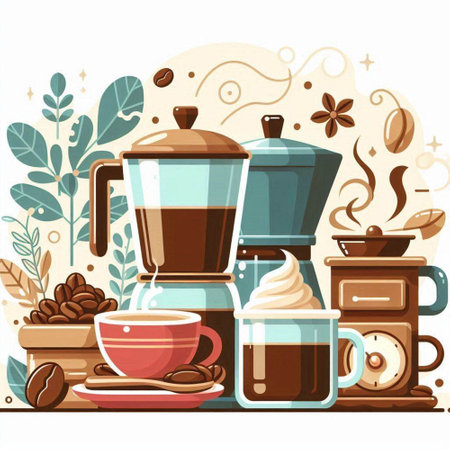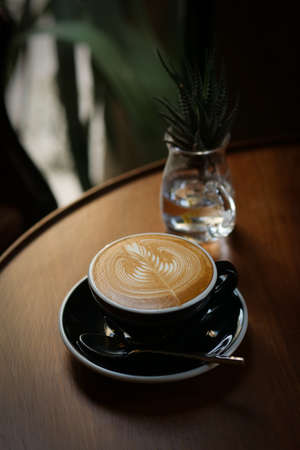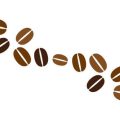Introduction: Coffee and Intermittent Fasting
Coffee is more than just a morning ritual for many Americans—its an essential part of daily life. As intermittent fasting (IF) continues to gain popularity across the United States, coffee has found a new role beyond its traditional wake-up call. For those following IF protocols, the type of coffee you choose can significantly impact your fasting experience, affecting everything from energy levels and appetite control to the overall success of your fasting goals. Whether youre practicing a 16:8, 18:6, or alternate-day fasting plan, understanding how coffee interacts with your fast is crucial. The right cup can help curb hunger pangs, boost metabolism, and provide mental clarity without breaking your fast. In this article, well explore why making informed coffee choices matters during intermittent fasting and how selecting the best brew can support your health journey while fitting seamlessly into the American lifestyle.
2. Black Coffee: The Ideal Fasting Brew
When it comes to intermittent fasting, black coffee consistently stands out as the top choice for coffee lovers who want to maximize their fasting results. The primary reason is simple: black coffee contains virtually zero calories, which means it wont break your fast or interfere with the metabolic benefits associated with fasting periods. Unlike sweetened or creamy coffee beverages, plain black coffee does not trigger an insulin response, allowing your body to remain in a fasted state and continue burning fat for fuel.
Besides being calorie-free, black coffee offers practical advantages for those practicing intermittent fasting:
| Coffee Type | Calories (per 8 oz) | Impact on Fasting |
|---|---|---|
| Black Coffee | 0-5 | No effect—preserves fasting benefits |
| Coffee with Sugar/Milk | 30-100+ | Can break fast by raising insulin and calories |
Another benefit of black coffee during a fast is its natural appetite-suppressing qualities. Many Americans find that sipping a hot cup of black coffee in the morning or during midday hunger pangs can help curb cravings and make sticking to their eating window easier. On top of that, caffeine in black coffee may give your metabolism a gentle boost, increasing energy expenditure and promoting fat oxidation—two perks that align perfectly with the goals of intermittent fasting.
In summary, if youre looking for the most effective brew while fasting, black coffee is hard to beat. Its zero-calorie profile, minimal impact on insulin levels, appetite control, and metabolism-enhancing properties make it the ideal companion for anyone committed to an intermittent fasting lifestyle.

3. Cold Brew and Iced Coffee: Chilled Options for Fasting
When it comes to intermittent fasting, cold brew and iced black coffee are quickly becoming staples among Americans seeking both flavor and function in their daily routines. Cold brew coffee, which is made by steeping coarsely ground beans in cold water for 12 to 24 hours, offers a smooth, mellow taste with lower acidity than traditional hot-brewed options—making it a favorite not only for its refreshing qualities but also for being gentler on the stomach during fasts. On the other hand, iced black coffee, typically brewed hot and then chilled or poured over ice, delivers a bold, classic coffee experience without added calories or sugars.
The growing trend of “grab-and-go” cold brew bottles and ready-to-drink iced coffees reflects America’s fast-paced lifestyle, especially among those who want to stay energized while fasting. The key benefit for intermittent fasters is that both options can be enjoyed completely black—no cream, sugar, or syrups needed—which means zero calories and no risk of breaking your fast. Major U.S. coffee chains now offer extensive cold brew and iced coffee menus, often spotlighting these as clean, low-calorie choices perfect for health-conscious consumers following fasting protocols.
With summer temperatures rising and more people adopting intermittent fasting as part of their wellness journey, cold brew and iced black coffee have become go-to solutions. Their versatility—serving as both a morning wake-up call and an afternoon pick-me-up—demonstrates why they’re trending in American cafes, grocery stores, and even home kitchens equipped with specialized cold brew makers. For those serious about maintaining their fast while enjoying great-tasting coffee, these chilled options strike the ideal balance between convenience, taste, and fasting-friendly benefits.
4. Americano and Espresso: Simple and Effective Choices
When it comes to intermittent fasting, Americanos and straight espresso shots are popular options for coffee lovers who want to keep things simple yet effective. Both drinks provide a robust caffeine kick without the added calories or sweeteners that can break your fast. Let’s take a closer look at why these two classic choices are favorites among American coffee drinkers.
Caffeine Content and Fasting Compatibility
Espresso is known for its concentrated flavor and high caffeine content per ounce, while an Americano, which is simply espresso diluted with hot water, offers a milder taste but still delivers an energy boost. Because neither drink includes milk, sugar, or syrups by default, they align perfectly with the requirements of most intermittent fasting protocols. Here’s a quick comparison:
| Beverage | Serving Size | Caffeine (approx.) | Additives |
|---|---|---|---|
| Espresso Shot | 1 oz | 63 mg | None |
| Americano | 8 oz | 63 mg (from 1 shot) | None |
Straightforward Preparation and Consistency
One major advantage of choosing either an Americano or straight espresso is consistency—no hidden ingredients, no surprises. You know exactly what you’re getting every time, making it easier to stick to your fasting plan. Just be sure to skip any added creamers, sweeteners, or flavored syrups.
Lifestyle Fit: Why Americans Love These Options
The popularity of Americanos and espressos in the U.S. comes down to practicality and convenience. Whether you’re grabbing a quick shot before work or sipping on a larger Americano during your fasting window, both options give you the energy lift you need without compromising your goals. In short, if you value simplicity and effectiveness, these straightforward coffees are tough to beat for intermittent fasting success.
5. Additives to Avoid During Fasting
When practicing intermittent fasting, the types of coffee you drink matter just as much as what you avoid putting in your cup. In the U.S., its common to reach for milk, cream, sugar, or flavored syrups to enhance your coffee. However, these popular additives can disrupt your fast by triggering an insulin response and adding calories that break the metabolic benefits of fasting.
Why Traditional Additives Break Your Fast
Milk and Cream: Even a small splash of dairy or non-dairy creamer contains proteins, fats, and sugars that can initiate digestion and spike insulin levels. This interrupts the fasting state and may reduce fat-burning benefits.
Sugar: Whether white, brown, raw, or in artificial sweetener blends with dextrose, sugar is a fast-breaker. It rapidly raises blood glucose and eliminates the calorie-free advantage of black coffee during your fasting window.
Syrups: Flavored syrups (like vanilla or caramel) are packed with sugar and often contain additional additives. These sweeteners quickly provide energy for your body to process, moving you out of a true fasted state.
Fast-Friendly Coffee Alternatives
If you prefer more flavor in your coffee but want to maintain your fast, opt for zero-calorie additions that dont provoke an insulin response.
- Cinnamon: Adds warmth and complexity without any calories.
- Vanilla Extract: A drop or two of pure vanilla extract (alcohol-based) can boost flavor with negligible caloric impact.
- Nutritional Yeast Flakes: For a savory twist, some Americans enjoy this non-caloric addition for its umami notes.
Avoid Artificial Sweeteners with Hidden Carbs
Some sweeteners marketed as “zero calorie” (like certain brands of stevia blends or sucralose packets) include fillers such as maltodextrin or dextrose, which can break a fast. Always check ingredient labels before adding anything new to your brew.
The Bottom Line
If maintaining your fast is your top priority, stick to black coffee or experiment with natural extracts and spices. By avoiding milk, cream, sugar, and syrups during your fasting window, youll maximize the health benefits of intermittent fasting while still enjoying America’s favorite morning beverage.
6. Decaf and Specialty Coffees: What About Caffeine-Free Options?
For many Americans practicing intermittent fasting, coffee is a go-to beverage for energy and appetite control. However, not everyone tolerates caffeine well, especially when fasting intensifies its effects. That’s where decaf and specialty caffeine-free coffees step in as excellent alternatives.
The Role of Decaf Coffee During Fasting
Decaf coffee offers the classic coffee flavor without the stimulating effects of caffeine. For fasters who experience jitters, anxiety, or trouble sleeping after regular coffee, decaf can be a game changer. Most American decaf options—whether drip brew, pour-over, or even cold brew—contain only trace amounts of caffeine (usually less than 5 mg per cup). This makes them suitable for late-day fasting windows or for individuals sensitive to stimulants.
How Decaf Fits Within IF Regimens
Decaf coffee is virtually calorie-free if you skip sweeteners and creamers, so it won’t break your fast. It can help suppress appetite through its warm liquid volume and provide a sense of routine during your fasting hours. Many fasters find that sipping on decaf in the afternoon helps curb cravings without risking sleep disruption at night.
Specialty Caffeine-Free Coffee Alternatives
American markets now feature a growing range of caffeine-free specialty brews beyond traditional decaf. Chicory root “coffee,” roasted barley drinks, and dandelion blends are popular choices for those seeking a rich, coffee-like experience without any caffeine content. These beverages are naturally free from calories and sugar when served plain, making them compatible with most intermittent fasting protocols.
Flavor & Experience Without Breaking Your Fast
Choosing quality decaf or specialty brews allows fasters to enjoy the ritual and taste of coffee without unintended side effects. For the best results, select products labeled as pure (no added sugars or artificial flavors) and prepare them black. Whether you’re on a 16:8 or an OMAD schedule, these beverages can seamlessly fit into your American fasting lifestyle—offering comfort, satisfaction, and variety while keeping your fast intact.
7. Tips for Making Fast-Friendly Coffee at Home
If youre looking to enjoy coffee during your intermittent fast and want to maximize both taste and fasting benefits, making your own brew at home is the way to go. Not only do you have full control over ingredients and brewing methods, but you can also save money and ensure your cup stays clean and compliant with your fasting plan. Here are some practical tips and gear recommendations tailored for the American lifestyle:
Choose Quality Beans and Go Black
Start with high-quality whole beans—look for single-origin or organic options if possible. Grinding fresh just before brewing will deliver a richer flavor profile. For intermittent fasting, stick to black coffee; avoid creamers, milk, sugar, or flavored syrups that could break your fast.
Select Your Brewing Method
- Drip Coffee Makers: Perfect for busy mornings and larger households. Models like the Bonavita Connoisseur or Technivorm Moccamaster are praised for their consistent temperature control and ease of use.
- French Press: Ideal for bold flavor lovers. The Bodum Chambord French Press is a popular pick—just coarse-grind your beans and steep for 4 minutes.
- Pourover: For those who appreciate ritual, a pourover like the Chemex or Hario V60 brings out nuanced notes. Pair with a gooseneck kettle for precise pouring.
- Keurig or Single-Serve Machines: If convenience is king, opt for reusable K-Cups so you can control what goes into your cup—just pure ground coffee, no additives.
Mind Your Water
The water-to-coffee ratio matters more than you might think. Use filtered water to avoid off-flavors, and aim for about 1 to 2 tablespoons of ground coffee per 6 ounces of water. Adjust strength to taste, but keep it black for fasting purposes.
Add Fasting-Friendly Enhancements (Optional)
If you need a little variety without breaking your fast, consider adding a pinch of cinnamon or Himalayan salt—both are calorie-free and can subtly enhance flavor without affecting your metabolic state.
Avoid Common Pitfalls
- Avoid all sweeteners—even calorie-free ones like stevia or sucralose—as some research suggests they might trigger insulin response in sensitive individuals.
- Skip bulletproof-style coffee with MCT oil or butter if youre aiming for a “clean” fast; these add calories that technically break your fast.
Make It Routine
Brew your coffee at home as part of your morning ritual. It’s not just about saving money—it helps you stay mindful about what goes in your cup and keeps you on track with your intermittent fasting goals. Plus, nothing beats the aroma of fresh coffee filling up your kitchen as you kick off another productive day!

